




Whether shipping by river, road or rail, the soy checkoff is committed to ensuring America’s infrastructure is a significant advantage for U.S. soybean farmers. We’re looking inside the bean, beyond the bushel and around the world to keep preference for U.S. soy strong. And it’s helping make a valuable impact for soybean farmers like you.
See more ways the soy checkoff is maximizing profit opportunities for soybean farmers at unitedsoybean.org





Patrick Knouff
Ohio Soybean Association President Shelby County soybean farmer
With the fall season fast approaching, all in our industry prepare for what I hope to be a great harvest season. It is these long, tough days that really make you appreciate time with family and friends even more. While we are out bringing in the harvest, the Ohio Soybean Association (OSA) and Ohio Soybean Council (OSC) are working hard to ensure that farmers are protected and the soybeans we bring in continue to have value across the globe.
Like most years, the summer months were a busy time for our organization. In July, we once again visited Washington, D.C., to discuss the importance of the 2023 Farm Bill. Our talks on Capitol Hill are some of my favorite events that OSA participates in. Meeting with members of Congress and explaining what Ohio farmers, and more specifically soybean farmers, have to offer always reminds me of why we do what we do in the first place.

Especially with the upcoming farm bill in mind, I will once again remind each and every one of you how crucial of a time we are living in for farmers across the country. Your voice is necessary and the best way to get your voice out there is through our memberships. Everything that we do is only possible because of the support from our members, and you can stay up to date on all OSA news by becoming a member at SoyOhio.org/Membership
Both OSC and OSA participated in the Ohio State Fair in July and August in Columbus, supporting the future of agriculture by providing fair items for livestock exhibitors through “Swag Bags/Buckets”. We had a presence all 12 days of the event and it is always good to see all that agriculture has to offer in one place. I would also like to congratulate former OSC Board Chairman Terry McClure on his induction into the Ohio Ag Hall of Fame during this year’s fair. You can read all about the extensive involvement at the Ohio State Fair on page 16.
This edition of Ohio Soybean News is themed around New Uses for soybeans. Ohio is an innovator in that area thanks to our own Airable Research Lab located at Ohio Wesleyan University in Delaware. Airable is the only research lab that exclusively looks to find new ways to utilize soy to solve industrial and consumer challenges. You can read more about Airable and a few of the products they have helped develop on pages 11-13.
Thank you once again for all that you do to support our organization, and I wish you and your families a safe, efficient and plentiful harvest in 2023!
Patrick Knouff
President
Patrick Knouff, Shelby County
Vice President
Rusty Goebel, Williams County
Treasurer
Bennett Musselman, Pickaway County
Secretary
Jeff McKanna, Hancock County
Chairman
Ryan Rhoades, Marion County
Trustees
David Clark, Warren County
Dustin Converse, Union County
Trish Cunningham, Union County
Justin Esselburn, Holmes County
Austin Heil, Hardin County
Caitlyn Heimerl, Industry Affiliate Ex-Officio
Jeff Magyar, Ashtabula County
Derek Reusser, Holmes County
Andy Stickel, Wood County
Bob Suver, Clark County
Kerrick Wilson, Preble County
Jennifer Wilson-Oechsle, Van Wert County
American Soybean Association
Board Representatives
Rusty Goebel
Scott Metzger
Ryan Rhoades
Staff Credits
Kirk Merritt - Publisher
Julia Brown - Editor
Eric Robinson - Staff Writer
Brent Warren - Art Director
Barry Falkner - Photo Quality/Proofer
Ohio Soybean News is published six times a year by the Ohio Soybean Association, 918 Proprietors Rd., Suite A, Worthington, OH 43085. Phone: 614-476-3100.
Comments and statewide news articles should be sent to the above address. Advertising space reservation must be made by the first of the month preceding publication. In consideration of the acceptance of advertisement, the agency and the advertiser must, in respect of the contents of the advertisement, indemnify and save the publisher harmless against any expense arising from claims or actions against the publisher because of the publication of the content of the advertisement.
For Advertising Sales Contact:
Matt Herman - (612) 812-5833 matt.herman@dtn.com
For Address Corrections Contact: Ohio Soybean News at 918 Proprietors Rd., Suite A, Worthington, OH 43085.
Web address: www.soyohio.org
E-mail: cdeboard@soyohio.org

Higher yields start with higher quality soybean seeds. Xitavo® soybean seed consistently outperforms the competition. Built with triple-stacked Enlist E3® technology and backed by soybean specialists from BASF, the result is yields that just keep growing and growing.

Seed done right.
If you are passionate about farming and ready to hone your leadership skills and connect with industry leaders committed to creating a better future for farmers, the ASA Corteva Agriscience Young Leader Program is for you!
Program owners American Soybean Association and Corteva Agriscience are seeking farmers to apply for the 40th Class of ASA Corteva Young Leaders!
ASA’s longest-running leadership program, Young Leaders was founded in 1984 and continues to set the bar for leadership training in agriculture, identifying and training new, innovative and
engaged growers to serve as the voice of the American farmer.
Phase I of the 2023–24 Young Leader program will take place Nov. 27-30 at Corteva’s Global Business Center in Johnston, Iowa. The program continues Feb. 27-March 1, 2024, in Houston in conjunction with the annual Commodity Classic Convention and Trade Show.
Soybean growers, both individuals and couples, are encouraged to apply for the program, which focuses on leadership and communication, agriculture trends and information, and the development of a strong and connected network. Not “young?" You can still apply:

Actual age isn’t important! Interested partners, even if not employed full time on the farm, are encouraged to attend and will be active participants in all aspects of the program.
ASA and Corteva Agriscience will work with the 26 state affiliates and the Grain Farmers of Ontario to identify the top producers to represent their states as part of this program.
Apply now at soygrowers.com u
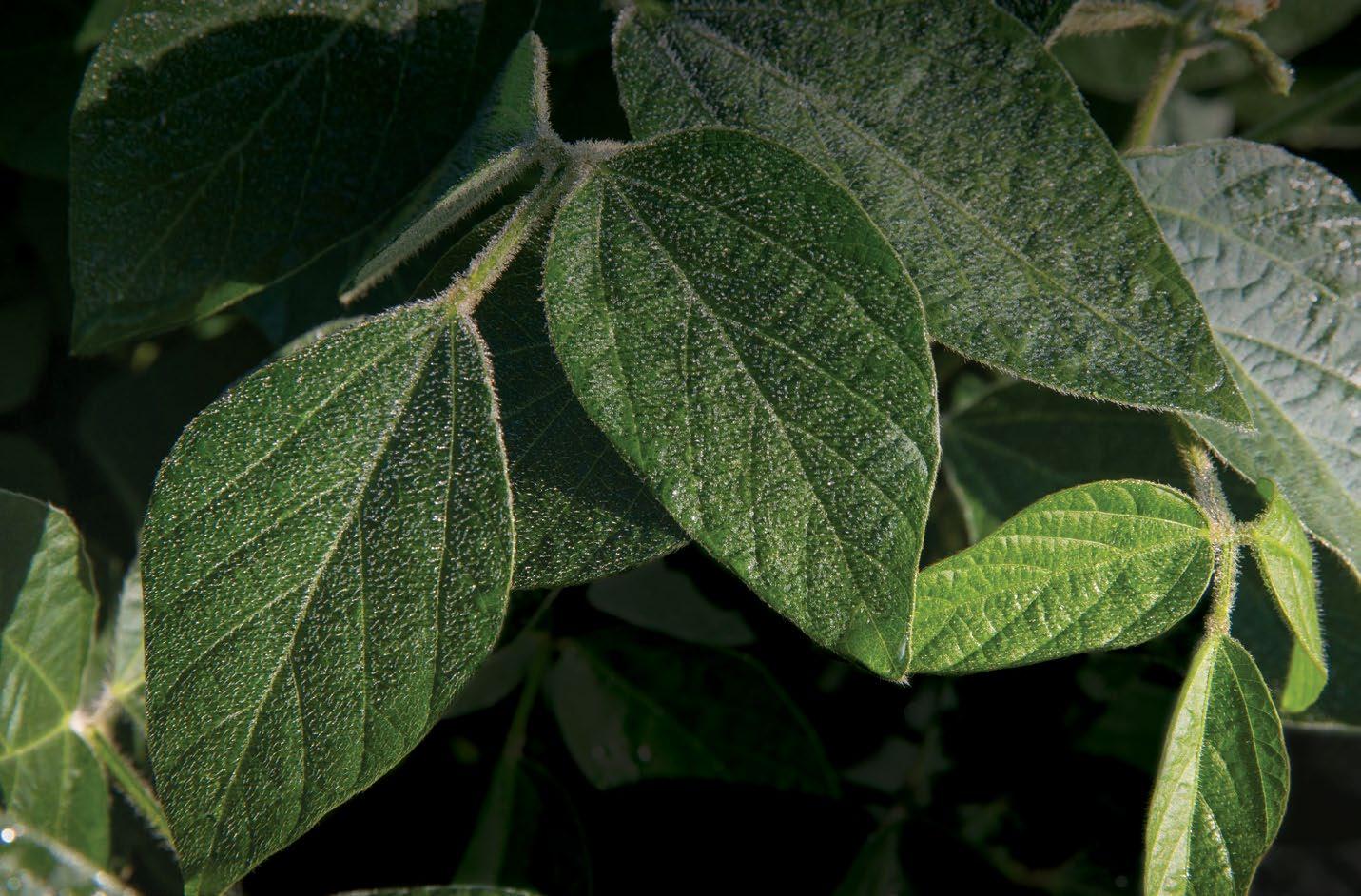
SOYLEIC® is a non-GMO, high-oleic option for today’s soybean farmers — and those they serve.
• Maturity Groups for Your Area
• Competitive Yields
• Added Value for Culinary and Livestock Markets
That means the future of a healthier food system isn’t manufactured — it’s grown. See why soybean farmers are embracing SOYLEIC®

soyleic.com
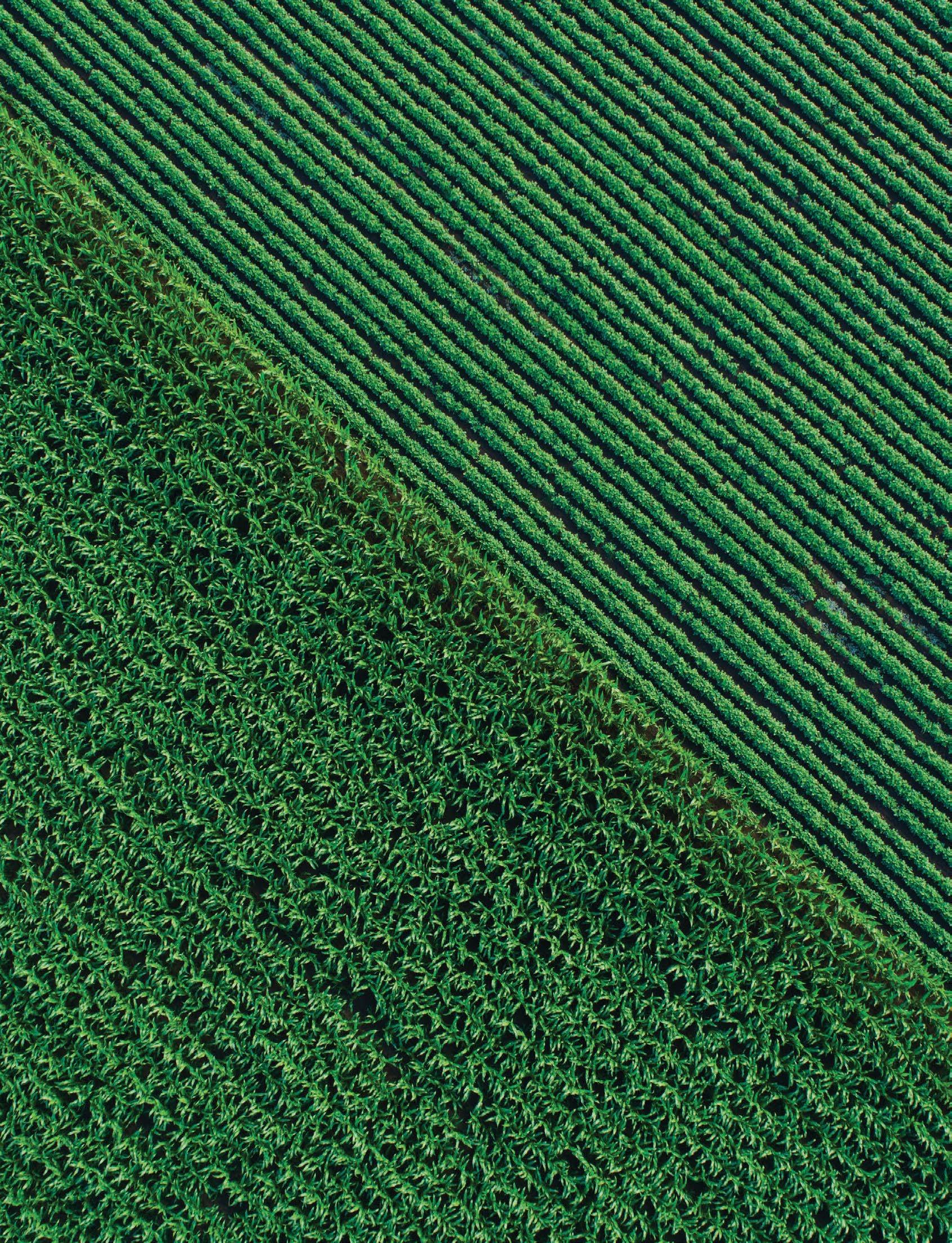

The long-term success of U.S. soy abroad would not be possible without the foresight of Congress to create public-private partnership programs at USDA to assist trade associations in promoting our products on a global stage. ASA is a longtime cooperator of these programs, particularly the Market Access Program (MAP) and the Foreign Market Development Program (FMD).
Utilizing MAP and FMD funds, the U.S. soy industry has leveraged those dollars to increase market access, address technical barriers to entry, and create demand for U.S. soy. Trade promotion programs are helpful in diversifying and expanding agricultural exports; this is particularly important as we consider rising tensions with China, the leading export market for many U.S. agricultural products.
MAP and FMD are successful public-private partnerships which are cooperative, cost-share programs between private industry groups representing farmers and USDA.
MAP partners USDA’s Foreign Agricultural Service (FAS) with U.S. agricultural trade associations, cooperatives, state regional trade groups and small businesses to share the costs of overseas marketing and promotional activities that help build commercial export markets for U.S. agricultural products and commodities. FMD funds projects that provide trade servicing and trade capacity building through efforts to open, expand and maintain long-term markets for U.S. agricultural products.
Utilizing MAP and FMD funds, ASA — through the Word Initiative for Soy and Human Health and U.S. Soybean Export Council — has leveraged those dollars to increase market access, address technical barriers to entry and create on-the- ground capacity and demand for U.S. soy.

While China remains the largest export market, trade promotion programs have allowed the U.S. soy industry to invest MAP and FMD dollars in new markets. A great example of this is Egypt. The U.S. soy industry has invested MAP and FMD dollars on the ground in Egypt to facilitate trade missions with Egyptian buyers, engage in-country with the local poultry and aquaculture industries, and build an understanding of the quality of U.S. soy with Egyptian customers. As their domestic poultry and aquaculture industries have grown, so too has their demand for high-quality, U.S. soybean meal to feed those animals and fish. Thanks to these critical investments, Egypt now sources more than 80% of its soy from the United States.
A core component of title III in the 2018 Farm Bill, commonly referred to the trade title, is the export market development programs, which include MAP and FMD.
These programs, however, are in desperate need of an increase in funding allocations. The MAP program was officially created in 1996, but authorization can be traced back to 1978, while FMD was created in
ASA’s World Initiative for Soy in Human Health (WISHH) used Foreign Market Development funds to provide training to SESACO Limited of Uganda so the company could expand its offerings of soy-protein based foods. Photo Credit: WISHH
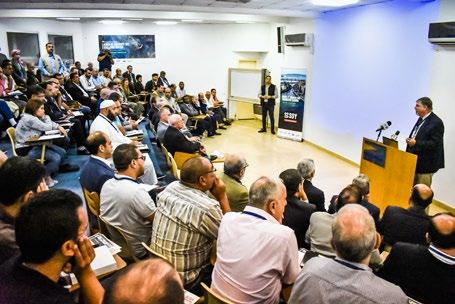
is home
Soy Excellence Center.
Stan Born delivers remarks at the opening of the center in Egypt in 2019.
1955. Available data about total export market development funding and partner contributions ends in 2019. However, MAP and FMD funding has not changed since fiscal years 2006 and 1997, respectively. Over that same time, partner funding continually grew to be about twice the level of federal resources. It is critical for the continued success of U.S. agriculture that Congress invest additional dollars in the Agricultural Trade Promotion and Facilitation Program in the 2023 Farm Bill. OSA and ASA strongly recommend doubling the minimum annual mandatory funding for the Market Access Program to $400 million and the Foreign Market Development Program to $69 million. u

In the middle of July, the Ohio Soybean Association (OSA) traveled to Washington, D.C., for the second time in 2023 to advocate for farmers across Ohio. Specifically, this trip was centered around the 2023 Farm Bill and its overall importance for soybean farmers in the Buckeye State. OSA board members who traveled to Capitol Hill included Vice
President Rusty Goebel of Williams County, Trish Cunningham of Union County, Scott Metzger of Ross County and Kerrick Wilson of Preble County, as well as OSA staff members Kirk Merritt and Madi Layman.
While in Washington, D.C., OSA met with the offices of the following nine congressional members:
• Brad Wenstrup (R-OH 2)
• Bob Latta (R-OH 5)
• Bill Johnson (R-OH 6)
• Max Miller (R-OH 7)
• Marcy Kaptur (D-OH 9)
• Mike Turner (R-OH 10)
• Mike Carey (R-OH 15)
• Senator J.D. Vance
• Senator Sherrod Brown
These meetings dove into why the upcoming farm bill is critical
to farmers and included points of importance shared with the American Soybean Association (ASA). A bipartisan, meaningful and comprehensive farm bill protects soybean farmers as well as the value of the soybeans grown. These topics included:
Improving the Title I farm safety
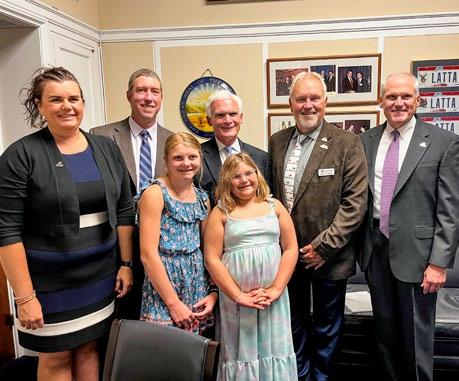



The Ohio Soybean Council wants growers to stay on top of the most recent agronomic discoveries. That’s why your soybean checko developed Field Leader, an online resource to give you access to the latest soybean research.
Find all the ways the Ohio Soybean Council and soybean checko work for you by clicking the “Ohio Field Leader” tab at OCJ.com.


net to be more responsive and predictable
• One improvement specifically that OSA focused on during this visit was to increase the soybean reference price, whether that be through a statutory reference price change, making adjustments
to the effective reference price, or a combination of the two.
Protecting and enhancing crop insurance to assist with volatile weather and crop loss
Expanding trade promotion programs to help grow and diversify agricultural markets


Enabling greater access to voluntary conservation programs to meet demand
Right now, you need a lender focused on farmers’ futures. As a lending cooperative owned by farmers, we are committed to farmers. That’s why our farmers have received an average 1.5% of their average daily loan balance back in cash for each of the last 4 years through our Patronage* program. It’s our way of supporting our farmers and strengthening their rural communities.
Visit FCMA.COM/PATRONAGE to start a conversation with your local lender.
Building biobased market opportunities to promote soy utilization
Providing biofuels opportunities to help the nation become more energy independent
• OSA continues to advocate for clean fuel infrastructure through programs such as the Higher Blends Infrastructure Incentive Program
Investing in research for innovation and competitiveness
Maintaining the farmerfinanced soybean research and promotion checkoff
“We’ve been working hard on behalf of our farmer-members discussing the farm bill and our priorities and how they impact soybean farmers,” Cunningham said. “We always love to share our message and work on behalf of Ohio farmer-members.”
The group also discussed increasing truck weight limits, specifically by adding the capabilities for six axles as opposed to five. Also during this visit, OSA attended the 2023 Soy Issues Forum with a Congressional Panel as well as a Board of Directors Meeting. u
Since 2019, Airable Research Lab has served as a business line of the Ohio Soybean Council (OSC), using checkoff funds from soybean farmers in the Buckeye State to fund solely soy-based product development. In its fourth year, Airable has taken that concept and proven just how much can be done with soybeans, partnering with major corporations and developing new products to improve the world we live in on a daily basis.
Located on Ohio Wesleyan’s campus in Delaware, Ohio, Airable’s goal is to maximize the value of soybeans for farmers across the state by taking those checkoff funds and turning them into something great through soy products and innovations. Since the lab’s inception, it has licensed and assisted with the commercialization of 7 soy-based products since 2019. These are real-world projects by an expert team that has 70 years of research
and development experience.
The main focus of many of Airable’s projects comes from soybean oil, as it serves as a natural replacement for petroleum oil. This way, consumers have opportunities to find products and services that are soy-based or biobased in nature.
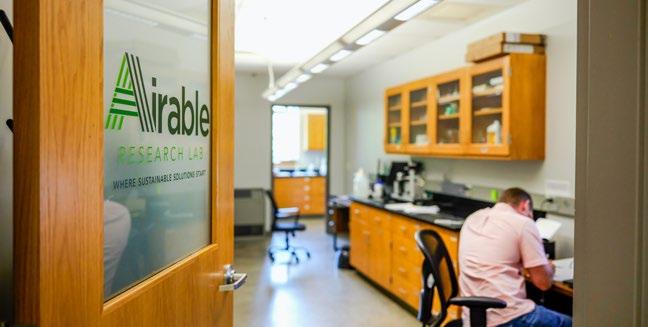
There are plenty of benefits to having a checkoff-funded lab as well. It allows more freedom to adapt. If Airable finds they can’t solve a problem, the lab can move on to another project quickly and decisively.

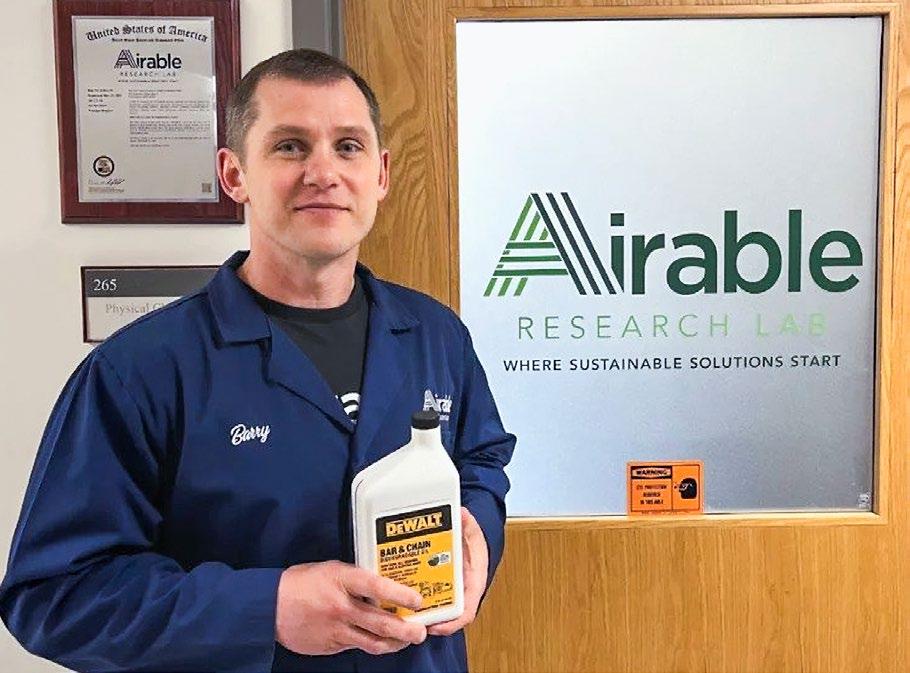
Intellectual property is also a big advantage for the lab. Controlling that piece of the puzzle can be important to investors. That opens the door to licensing opportunities as well that bring the possibility of royalties coming back to the lab and real dollars that came from farmers coming back to benefit other projects.
That money that would go to research and development costs elsewhere stays with the lab and with the farmers. It’s a benefit for those other companies as well. Airable can provide up to four times the number of hours in the lab per project when compared to other research labs, saving companies both time and money, and creating more bang for the buck.
We are also living in a world where sustainability is becoming more important. Corporations have sustainability goals, and utilizing the oil in soybeans helps those companies achieve those goals, while also saving money.
As the only known lab that focuses exclusively on soybeans, Airable is also able to build a reputation as a leader in the space. In addition to Ohio, five other state soybean boards have partnered with Airable, validating the concept is working in the Buckeye State, and working toward a bright future for Ohio soybeans. u
Every day, new ideas are being developed at Airable Research Lab. Whether it is an idea or a technology, innovation is constantly the theme of the Ohio Soybean Council’s checkofffunded soy-based lab. Here are just a few of these innovations that are coming out of Delaware, Ohio.

Roof Maxx:
Roof Maxx is a powerful roof shingle sealer-rejuvenator derived from soybean oil. The primary component of Roof Maxx is soybean oil methyl esters, obtained by the transesterification of soybean oil. This chemistry offers an excellent non-toxic and biodegradable substitute for petroleum-based solvents. When applied, Roof Maxx extends the roofing material’s life by reducing the surface energy and shrinkage that limits expansion and contraction of the asphalt shingles, making them inflexible. SoyFusion Technology allows millions of microdroplets of oil to quickly penetrate the brittle protective top coating and saturate the weathering asphalt layer. This infusion rejuvenates the asphalt, restoring its flexibility and pliability. Roof Maxx also enhances adhesion of the protective mineral granules, which work like sunscreen, reflecting the sun’s ultraviolet rays, the
main source of physical/chemical degradation of roof materials. Roof Maxx can extend the life of your existing roof up to 5 years with a single treatment and up to 15 years with repeated treatments.
DeWalt
Oil is a high-performance biobased formulation that is compatible with all gas and battery-operated saws. As chainsaw oil is a 100 percent loss application, meaning 100 percent of the oil ends up in the environment, which includes soil, groundwater and emissions dissipating into the air, it’s important to use a biodegradable product to help reduce environmental pollution. This All-Seasons -15°F biobased chainsaw oil has a higher viscosity index than any petroleum chainsaw oil and is a USDA Certified Biobased Product. Tested on thousands of cuts with temperatures measured on the bar, motor and electronics, this oil is designed to help maximize bar and chain life while being safer for the planet. The soy oil used is sourced from Owensboro Grain (OG) in Kentucky and manufactured in Ohio. While this is not the first biobased bar and chain oil to reach the marketplace, it’s the first one to tout the benefits of soy oil, and the ONLY bar and chain oil that is Certified Ultimate

biodegradable and independently tested by a leading university for performance. It is rigorously tested, and the price point is commensurate with synthetic bar and chain oils on the market.

Conditioners are important for maintaining leather goods. These compounds soften the material to prevent cracking, diminish moisture loss that leads to drying, smooth out small scratches, clean and protect the surface, and revitalize the leather’s luster. However, most leather conditioners on the market today include petroleum. Depending on the grade, crudeoil-based ingredients can dry out the leather, and petroleum of any quality has a negative environmental impact. Airable Research Lab has formulated a soy-based leather conditioner that can extend the life of leather products. This eco-friendly treatment is as effective as its petroleum-based competitors. The soy-based conditioner has broad applicability for both industrial and domestic uses:
• Automotive (car upholstery)
• Home furniture (couches, chairs)
• Apparel (coats, sneakers, belts)
• Recreational (baseball gloves, saddles)

Airable Research Lab has synthesized a renewable, soy-based oil that can replace silicone oil in formulations. The product can be used as a low-temperature silicone replacement in formulations (polishes and lubricants), with broad potential applicability, from home DIY projects to industrial uses. The product incorporates functionalized epoxidized soybean oil (ESBO), adding functionality to the oil: improved wetting to substrates, better lubrication, decreased friction and enhanced hydrophobicity. The structure indicates inherent corrosion inhibition. Airable developed two formulations of the soybased oil and analyzed them, comparing their characteristics with a baseline soybean oil and a commercial silicone oil.
Enzomeal:
An advanced soybean-based fish feed, EnzoMeal addresses a key impediment to widespread expansion of aquaculture, the fastest-growing food production sector. Historically, fisheries have used fishmeal as fish feed, but
the primary ingredients — wild fish and shrimp — are rapidly dwindling resources, making the feed expensive and unsustainable. Soybean meal presents an attractive alternative. It closely meets the dietary requirements of fish: it is rich in protein content, essential fatty acids, and unsaturated fats, and it has the most balanced amino acid composition of all agriculturalbased meals. Yet conventional

soybean meal contains carbohydrates that fish cannot easily digest. Airable Research Lab partnered with Battelle to develop a technology that removes nondigestible carbohydrates and increases crude proteins in the soybean meal, resolving the challenges that to date have limited soybean use as a substitute fish
feed protein. Enzomeal received the 2017 R&D 100 Gold Special Recognition Award — the highest level of this prestigious award for invention and innovation — in the Corporate Social Responsibility category.

Airable Research Lab and Gear Head Lube partnered to identify a commercial soy-based wax formulation that provides an alternative to petroleum-based microcrystalline wax. Gear Head is using the biobased wax in its fifth wheel lubricant product. Airable identified an appropriate soy-based wax grade that proved better for this application. Soybean oil can be fully hydrogenated, increasing the melting onset point and crystallinity. The processing yields a wax with a higher melting temperature and thermal stability than partially hydrogenated oils typically used in food, candles, or personal care products. Airable formulated the soy-based wax into a usable product that provides a durable, water-repellent coating that is easier to handle and store in warm-to-hot ambient temperatures. The value includes:
• Free of petroleum-based paraffins
• Higher melting onset temperature
• 100% biobased carbon
• Made from widely available renewable resources
• Durable
• Water-repellent u
It all started with a phone call.
Chief Laboratory Officer of Airable Research Lab Barry McGraw called the then Innovation Director and Chair of the Chemistry Department at Ohio Wesleyan University Dale Brugh and pitched him the idea of leasing his chemistry lab to him, starting the beginning of a great partnership between the two organizations.
McGraw cleaned out the lab and about one year later the idea of Airable was formed. Initially the partnership consisted of only one lab, but fast forward to today, and the lab has grown to feature four labs, seven full-time employees, four key consultants and a three-year lease with the university.
Megan Ellis, Executive Director of the OWU Connection has worked with McGraw and Airable since the partnership began and, in her role, helps connect students with opportunities on campus, such as the lab.
“Barry McGraw and I began collaborating soon after his work at OWU began,” Ellis said. “We realized the goal of Airable and OWU were so closely aligned — innovation, increasing access, participation in research and beyond classroom experiences.”
Since then, the relationship between the two entities has only gotten stronger.
“We’ve grown from Airable simply renting a chemistry lab to the point now where Airable is a key partner in STEM activity on campus, a vital part of the ecosystem within the STEM career community, STEM academic areas and entrepreneurial ecosystem,” Ellis said.
Airable’s presence on campus has led to many opportunities for students at Ohio Wesleyan with



Airable Research Lab has been a fixture at Ohio Wesleyan University, providing students with real-world experiences through internships.
the lab located in the Schimmel/ Conrades Science Center near the center of campus. The Airable team is very involved with that campus and organic and natural interactions have led to the students learning a lot from Airable.
These interactions have also led to real-world experiences for the Ohio Wesleyan students.
“Airable has become woven into the fabric of many students’ lives, specifically those in STEM-related
fields. Multiple OWU students have interned and worked for Airable in research, lab, chemistry and business positions. Additionally, the Airable team have been open to career and graduate school discussions and have served as mentors for countless OWU students,” Ellis said.
The symbiotic relationship that has formed between Ohio Wesleyan and Airable Research Lab is one that has grown to be invaluable for both parties. Airable now has a full-fledged research lab, which allows the team to create products and innovations all on their own instead of having to go to a third party. Ohio Wesleyan now has an industry leader to provide real-world experience on top of what students learn in the classroom.
Ellis said that she appreciates the Airable Team and what they have brought to campus.
“The partnership with Airable is incredible. Barry has created an incredible team. They are kind and thoughtful, incredibly smart and personable. They have placed value on being a part of the OWU Community, and we’re better for them being here.” u
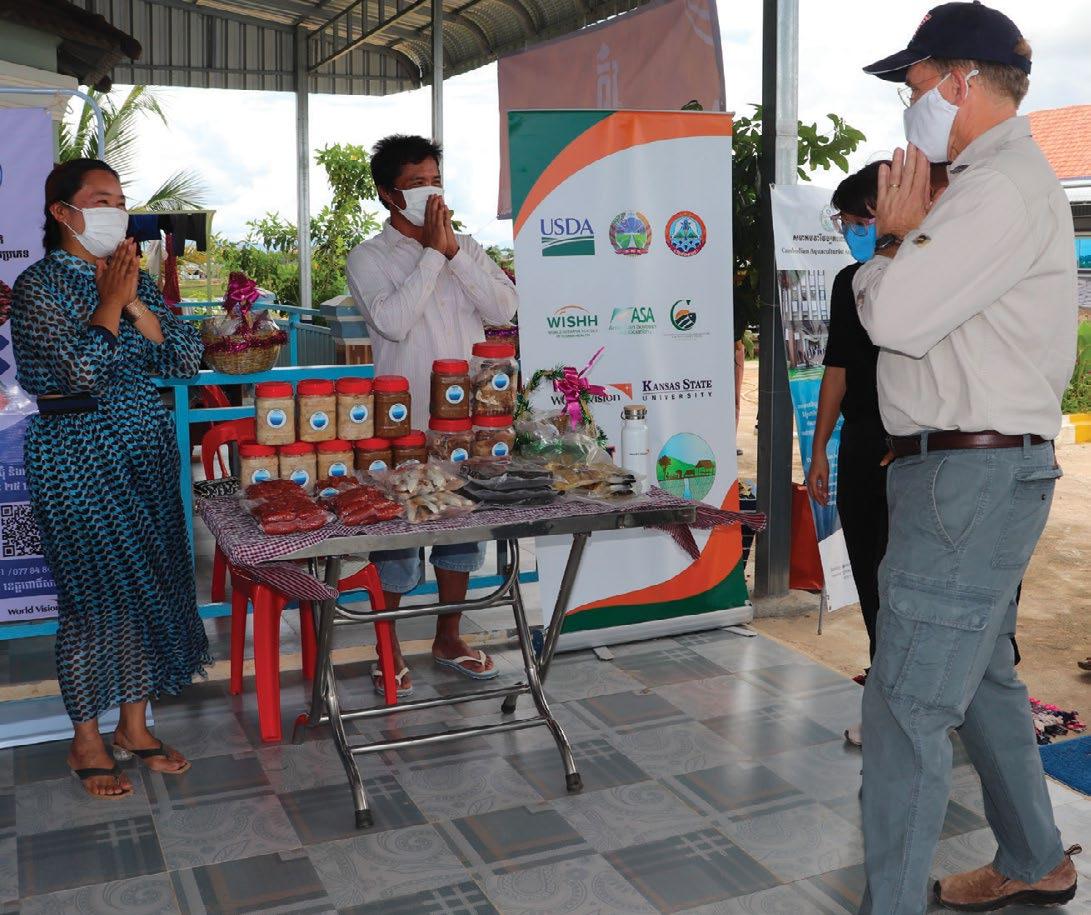

One of the staples of Ohio agriculture returned once again in 2023. The Ohio State Fair ran this year from July 26-August 6 and saw record-setting auction numbers at the Sale of Champions. It also saw the final State Fair for fair general manager Virgil Strickler as he heads into retirement.
As in previous years, the Ohio Soybean Council (OSC) had several footprints across the fairgrounds during its twelve-day period. In partnership with the Ohio Farm Bureau Federation, OSC remained a main draw in the Donahey Agriculture and Horticulture building in the Land and Living section of the fair.
This year, OSC debuted a brand new display, featuring eight towers of soybean facts ranging from new uses to animal agriculture. Fairgoers could follow the display and play along with a game of “Bean-Go”, a bingo game that taught all about soybeans. To go with the new towers, an electronic trivia game was available to play alongside a biodiesel wheel and an
educational exhibit on Genetically Modified Organisms (GMOs). Ohio Soybean Council staff and farmers engaged in many conversations around topics such as soybean nutrition, the work that goes into farming soybeans as well as all of the diverse products that can be made from soybeans.
“I think it’s important that we interact with the consumer and explain how soybeans go not just to livestock but toward other uses as well. There are many commercial soy products that people use every day. The more communication we can have with the public about our crop the better, and the value we got out of the 12 days at the fair this year is invaluable,” said OSC board member and Van Wert County soybean farmer Mike Heffelfinger
Additionally, GrowNextGen ambassadors from OSC’s education program taught all ages about water quality and biodiesel. These two demonstrations on top of all of the new displays and activities had
Logan County farmer Bill Bayliss stands in front of new OSC tower display.
fairgoers leaving knowing more about the importance and prevalence of Ohio’s number one industry.
Also returning again was another fair-favorite from OSC in the “Swag Buckets”. Animal agriculture is the soybean industry’s number one customer, with millions of bushels of Ohio soybeans being fed to pigs, chickens, cattle and other livestock and poultry every year. To partner with and support these hardworking groups, each livestock exhibitor at the fair this year received a free t-shirt, courtesy of OSC and Farm Credit, and other fun swag that would be useful on show day.
During the second week of the fair, OSC ventured outside of the Ag and Hort building to the lawn just outside of the Voinovich Livestock Center, where a second booth was set up featuring our infamous trivia wheel to connect with an even wider audience. Here fairgoers were met with more conversations about the value of soybeans and usually left with an animal stress reliever or a cooling towel to combat the
GrowNextGen Ambassadors show Representative Rodney Creech about biofuels.


fluctuating heat that is synonymous with the Ohio State Fair. This opportunity gave OSC another chance to put farmers directly in front of the consumer and show the Buckeye State all that the soybean industry has to offer.
Capping off the 12-day event was the 57th annual Ohio Agricultural

Hall of Fame Breakfast at Kasich Hall on Friday, August 4. Each year, The Ohio Agricultural Council accepts nominations for individuals who have enhanced the agricultural community and have helped promote the industry. This year, four individuals were honored by the OAC and inducted into the Hall of Fame.
OSC with new Ohio Ag Hall of Fame member Terry McClure
Marion County farmer Mike Ralph at the soybean tent outside of the Voinovich Livestock Center
Kenneth Davis, Thomas Menke, Dr. Don Sanders and former OSC Board Chairman Terry McClure were celebrated at the three-hour event that featured an opening speech by Gov. Mike DeWine.
Your soybean checkoff is a proud supporter of the Ohio State Fair and all of its attendees. From educating the general public on the soybean industry to supporting those showing in the ring. OSC hopes everyone filled up on the fair food — possibly fried with soybean oil — and looks forward to seeing you all again next year. u






1
3 4 5 6 2 3 4 5 6
Airable moves forward with the product 1
The outside company approaches with a general idea for a soybased technology or product.
Airable sets up a kick-off meeting to understand the need, targets, scope and timeline
Airable prepares a Proof-ofPrinciple (PoP) Project plan for 3-4 months and sends it to the company
The company approves and Airable begins work
Airable sends samples for application testing and the company provides feedback
2












Airable is founded as a business line of the Ohio Soybean Council
During the year, Airable conducts between 12-20 projects at a time.
12-20
8-12 In those projects, Airable works with 8-12 commercial clients at a time
OSC/Airable Research Lab have won seven R&D 100 Awards in the past 10 years and 12 awards overall
7
7 Airable has licensed and assisted with the commercialization of 7 soy-based products since 2019
Airable employees have 70 years of R&D Experience

70
The Airable Research Lab board is a crucial part of the Airable team and has been since 2019, when Airable Research Lab was created. Learn more about the OSC-funded research lab from four board members: Preble County farmer and President of the Airable board Keith Kemp, Auglaize County farmer Jerry Bambauer, Roof Maxx Co-founder and CEO Mike Feazel, and Ashtabula County farmer Jeff Magyar.
Q: How long have you been on the Airable Board?
Kemp: I have been on the board since 2019 and the President since 2021.
Bambauer: I am finishing my second year as a Board Member of Airable Research Lab.
Feazel: I have been on the board for two years.
Magyar: Since its conception I am proud to have worked with other board members to push across the line to get it started.
Q: Why did you want to join the Airable Board?
Kemp: It’s fascinating to see all the new uses and soybean products. Barry [McGraw] does a great job of working with manufacturers, which makes it exciting to be involved. It’s been great to watch it grow to where it’s at today.
Bambauer: I was chairman of the Research Committee of Ohio Soybean Council and the Airable Lab seemed like an interesting and good fit for me. Airable presented a great opportunity for me to be a part of the grassroots of Airable Lab Research.
Feazel: Airable has been instrumental to my company's success, and I realize its value in
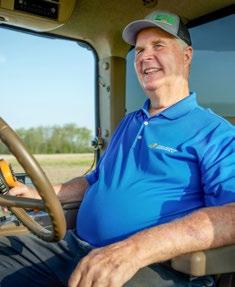

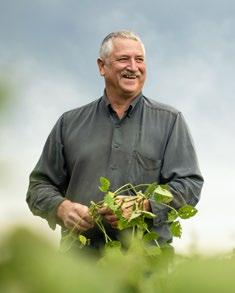

bringing new products/services to market.
Magyar: I had really enjoyed working with Barry McGraw. I knew he would take it to the next level, but I had no idea he would take it to the level it is at in such a short time. He has exceeded my expectations of what the lab can do in the soybean industry.
Q: Why do you think Airable is important:
Kemp: It’s important for new product development, and it’s very exciting to see everything unfold. The patent process is amazing to watch from start to finish and it’s a cool experience to see products like the DeWalt Bar and Chain Oil and many other products go out and actually be sold to the public.
Bambauer: OSC developed a strategic plan to manage and develop ways to improve the value of soybeans by research into new product development and new uses for soybeans. Airable Research Lab is an integral part of our work in Ohio, and participating states, to develop and improve new soybean products.
Feazel: They’re the only “Soy” specialists in the R&D space, which gives them and the clients they serve an advantage.
Magyar: It just makes sense to me to do research in-house to be able to kill a project quickly if it doesn't work, which saves checkoff dollars. It is also obvious that other Qualified State Soybean Boards (QSSBs) see the value because of how heavily they are investing in Airable Research Lab. It is a shining star for the Ohio Soybean Council.
Q: What has been the best experience you’ve had on the board so far?
Kemp: Seeing the bar and chain oil come to fruition was a great experience. Seeing the Ohio Soybean logo on the containers and being sold at stores has been really exciting. It’s an Ohio product. It’s also been exciting to see other states hop on board. Watching those relationships grow has been awesome.
Bambauer: I highly value the enthusiasm of our industry partners for developing soybean products which provide new uses and commercial production of our soybean projects. Each new product we develop increases our value for our soybean industry.
Feazel: Watching the lab's employees grow into a solid team focused on real-world, businessdriven results.
Magyar: Meeting with other QSSB members from other states and seeing how excited they are after touring Airable Research Lab and seeing the great work that Barry and his team do. It's a reminder to Ohio board members of the great work they do because we are used to it and expect it. u
Barry McGraw is the driving force behind Airable Research Lab. His interest in soybeans goes way back — to before he founded the lab, and even before he joined the Ohio Soybean Council (OSC) as the Director of Product Development & Commercialization. His interest in sustainable R&D goes back even further, to his first job as a researcher. And his interest in Ohio ...
Well, let’s just begin at the beginning.

McGraw is Ohio through and through, having grown up in the tiny town of Sciotoville. His bachelor's degree in plastics engineering comes from Shawnee State University in Portsmouth, an academic adventure supported by a basketball scholarship for the first three years (he played shooting guard). In his final year, McGraw concurrently held down both a full academic schedule and a full-time job at a sheet molding compound plant in Jackson. He applied his education to solving the company’s material and processing challenges, dipping his toe into the industrial waters that helped steer the Airable mission.
After graduating, McGraw joined Battelle, the world’s largest non-government research facility (and yes, it’s also in Ohio). He joined Battelle as a researcher in the Polymer Center, where he discovered his love for R&D. “I love juggling 20 things at once — 'organized chaos’ — and solving problems,” he says. McGraw worked his way up the ladder, becoming
the deputy director of Battelle’s Internal Research and Development division, managing over 80 IR&D and university projects, and then the program manager for the facility’s energy, health and environment work.
Over his 15 years with Battelle, McGraw played a key role on the biobased team, focusing on product development and commercialization.
His work at Battelle led to his connection with OSC — and his passion for working with soybeans. “I really love working for soy farmers. It’s going back to my roots. Farmers are hardworking, humble and entrepreneurial-minded.
“And I enjoy developing new soy-based products,” McGraw adds. “It’s like building something. When you’re done, you can sit back and say, ‘I had a part in making that’.”
Thus, McGraw formally became part of the OSC family in 2013, exploring opportunities to foster new soy technologies and to commercialize emerging soy-based products. During the seven years McGraw was in that role, the Council received seven R&D 100 awards for innovative and sustainable soy-based products.
Fun fact: McGraw has completed seven Spartan and Tough Mudder obstacle courses. So far. He enjoys a challenge!
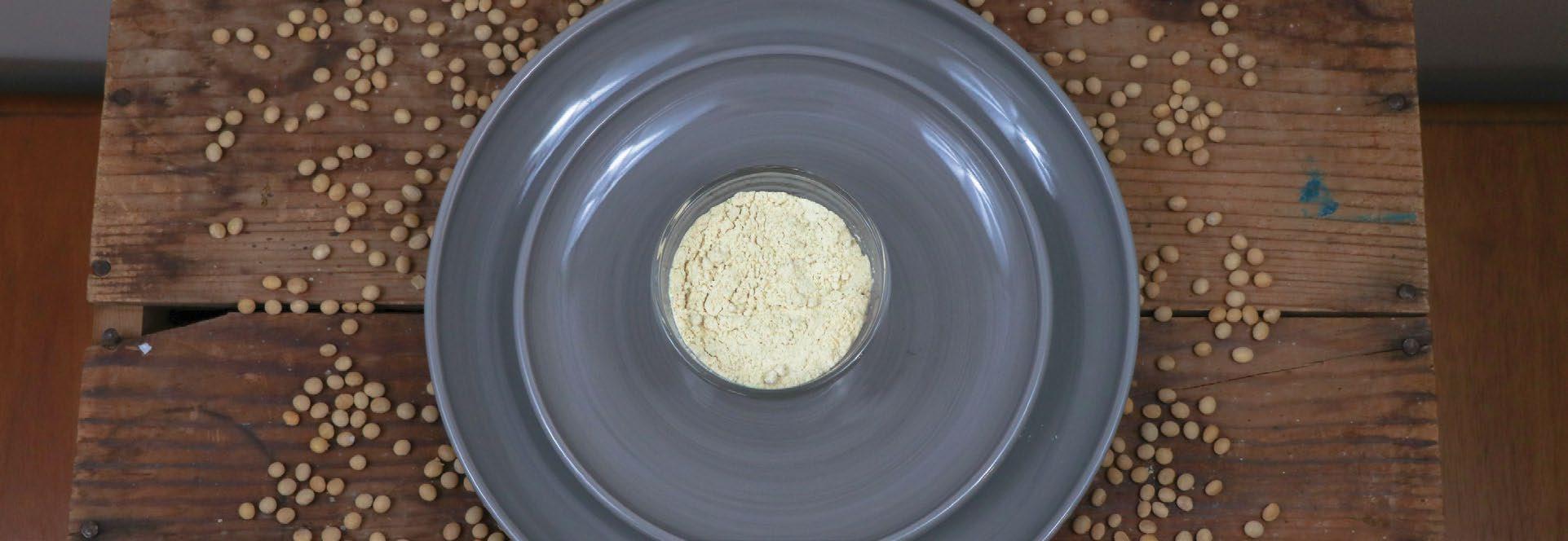

In 2019, McGraw had an epiphany. “Why,” he wondered, “are we funding other researchers? Why are we supporting other people’s visions?” McGraw recognized an opportunity: bring R&D in-house, work on more projects for less money, control the scope, retain intellectual property from successful endeavors — in short, use our resources to manifest the OSC vision.
And so, a lab was born. And how it has grown! Under McGraw’s leadership, the lab has acquired five funding partners in states with Qualified State Soybean Boards. Airable has a seven-person research team and is looking for new additions. The lab also boasts a growing list of commercial clients, all looking to benefit from the flourishing market for greener products.
McGraw, an Ohio native, has made good: his home state is becoming a leader in the booming field of soy-based R&D. u





Find out how ASA/WISHH’s soy checkoff-supported work with Edesia Nutrition led to the company developing a product that contains 25% more soy flour than earlier formulations. Adding more soy allows Edesia to reach more people throughout the world.









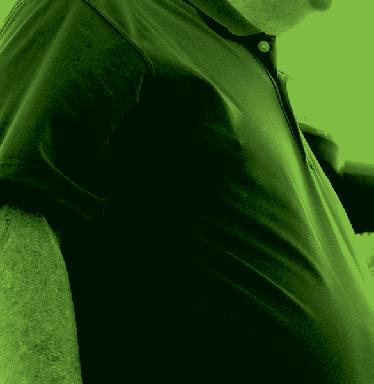





“It goes right back to our return on investment. Farmers are really seeing the checko programs are of value. They see the new products, the new research, it’s very hands-on and every farmer can be involved with it. ”
- KEITH KEMP, SOYBEAN GROWER WEST MANCHESTER, OH









Being involved and informed on soy-based innovations is an important part of moving your operation into the future. By investing in the Ohio Soybean Council, farmers get a firsthand look at the new products and research that are revolutionizing the industry, helping to further global demand, improve yields and create new opportunities for future generations.
Learn more at SoyOhio.org/HereWeGrow.




